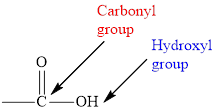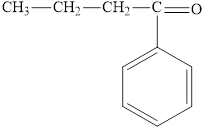
Concept explainers
(a)
Interpretation:The family (functional group) present in the given compound has to be written.
The given compound is,

Concept Introduction :

In carboxylic acid, the second oxygen atom is linked to a hydrogen atom.
The general formula for carboxylic acid is
(a)
Answer to Problem 72A
The given compound belongs to the family of carboxylic acid.
Explanation of Solution
The given compound is,

The compound 3-phenylpropanoic acid is acarboxylic acid.
In carboxylic acid, the second oxygen atom is bonded to a hydrogen atom.
The presence of carboxylic acid is identified by the presence of carboxyl group attached to the hydrocarbon chain.

The given compound belongs to the family of carboxylic acid.
(b)
Interpretation:The family (functional group) present in the given compound has to be written.
The given compound is,

Concept Introduction:

In ketones, the carbonyl group is bond to two carbon atoms. The general formula of a ketone is

In a ketone, the carbonyl group is not present at the end of the hydrocarbon chain.
(b)
Answer to Problem 72A
The given compound belongs to the family of ketones.
Explanation of Solution
(c)
Interpretation:The family (functional group) present in the given compound has to be written.
The given compound is,

Concept IntroductionEsters are carboxylic acid derivatives. The carbonyl group of the ester is polar. The general structure of ester is,

In an ester, the second oxygen atom is linked to another carbon atom.
The general formula for ester is
(c)
Answer to Problem 72A
The given compound belongs to the family of esters.
Explanation of Solution
The given compound is,

The compound phenethyl propanoate is an ester.
Esters are carboxylic acid derivatives. The carbonyl group of the ester is polar and can participate in dipole-dipole attractions.

In an ester, the second oxygen atom is bonded to another carbon atom.
The general formula for ester is
The compounds shows the presence two different alkyl groups bonded to carbonyl carbon.

The given compound belongs to the family of esters.
(d)
Interpretation:The family (functional group) present in the given compound has to be written.
The given compound is,

Concept Introduction:Organic compounds that contain a hydroxyl group that is covalently bonded to a carbon atom. Alcohols are classified into,
- Primary alcohol: One organic group attached to hydroxyl atom.
- Secondary alcohol: Two organic groups bonded to hydroxyl atom.
- Tertiary alcohol: Three organic groups bonded to hydroxyl atom.
The general formula for alcohol is,
Primary alcohol:
Secondary alcohol:
Tertiary alcohol:
(d)
Answer to Problem 72A
The given compound belongs to the family of alcohols.
Explanation of Solution
The given compound is,

The compound 2-ethylphenol is an alcohol.
The compound shows the presence of hydroxyl functional group and thus, it belongs to class of alcohols.
Chapter 20 Solutions
World of Chemistry, 3rd edition
- Predict the major products of this organic reaction: HBr (1 equiv) cold ? Some important notes: • Draw the major product, or products, of this reaction in the drawing area below. • You can draw the products in any arrangement you like. • Pay careful attention to the reaction conditions, and only include the major products. • Be sure to use wedge and dash bonds when necessary, for example to distinguish between major products that are enantiomers. • Note that there is only 1 equivalent of HBr reactant, so you need not consider the case of multiple additions. dm Re Explanation Check ©2025 McGraw Hill LLC. All Rights Reserved. Termarrow_forwardb) Use curved arrows to show the reaction of the radical with hydrogen bromide. Br: Br H .. Answer Bankarrow_forwardIndicate the reaction products when CH3COCH2COOCH2COOC2H5 (ethyl acetoacetoacetate) reacts with 1º OH-/H2O and 2º H3O+arrow_forward
- Indicate whether the product of the reaction between Naphthalene and CrO3 in acetic acid at 25ºC is 1,4 naphthoquinone or phthalic anhydride.arrow_forwardIndicate the products of the reaction between CH3COCH2COOC2H5 and Na+-OC2H5.arrow_forwardPrimary, Secondary, and Tertiary Alcohols O-H O-H O-H R₁-C-H R₁-C-H R₁-C-R₁ H R₂ R₂ Primary Alcohol Secondary Alcohol ChemistryLearner.com R stands for Carbon group like ethyl methyl propyl Tertiary Alcohol If 1 carbon group with two H attached to alcoholic carbon, then primary If 2 carbon group and 1 H are attached to alcoholic carbon, then secondary IF 3 carbon group and no H attach to alcoholic carbon then tertiary. The bottom line Starting "Weak" oxidant material PCC, DMP, Swern, etc Primary alcohol Aldehyde OH Secondary alcohol Ketone OH "Strong" oxidant KMnO4, H₂CrO4 (or equivalent) OH Carboxylic acid 요 Ketone No reaction No reaction Tertiary alcohol 1. Is ethanol a primary, secondary, or tertiary alcohol? Write out the structures of ethanol and any oxidation products of ethanol. If there is more than one oxidation product, give the structure of each of the products. 2. Is 2-propanol a primary, secondary, or tertiary alcohol? Write out the structures of 2-propanol and any…arrow_forward
 ChemistryChemistryISBN:9781305957404Author:Steven S. Zumdahl, Susan A. Zumdahl, Donald J. DeCostePublisher:Cengage Learning
ChemistryChemistryISBN:9781305957404Author:Steven S. Zumdahl, Susan A. Zumdahl, Donald J. DeCostePublisher:Cengage Learning ChemistryChemistryISBN:9781259911156Author:Raymond Chang Dr., Jason Overby ProfessorPublisher:McGraw-Hill Education
ChemistryChemistryISBN:9781259911156Author:Raymond Chang Dr., Jason Overby ProfessorPublisher:McGraw-Hill Education Principles of Instrumental AnalysisChemistryISBN:9781305577213Author:Douglas A. Skoog, F. James Holler, Stanley R. CrouchPublisher:Cengage Learning
Principles of Instrumental AnalysisChemistryISBN:9781305577213Author:Douglas A. Skoog, F. James Holler, Stanley R. CrouchPublisher:Cengage Learning Organic ChemistryChemistryISBN:9780078021558Author:Janice Gorzynski Smith Dr.Publisher:McGraw-Hill Education
Organic ChemistryChemistryISBN:9780078021558Author:Janice Gorzynski Smith Dr.Publisher:McGraw-Hill Education Chemistry: Principles and ReactionsChemistryISBN:9781305079373Author:William L. Masterton, Cecile N. HurleyPublisher:Cengage Learning
Chemistry: Principles and ReactionsChemistryISBN:9781305079373Author:William L. Masterton, Cecile N. HurleyPublisher:Cengage Learning Elementary Principles of Chemical Processes, Bind...ChemistryISBN:9781118431221Author:Richard M. Felder, Ronald W. Rousseau, Lisa G. BullardPublisher:WILEY
Elementary Principles of Chemical Processes, Bind...ChemistryISBN:9781118431221Author:Richard M. Felder, Ronald W. Rousseau, Lisa G. BullardPublisher:WILEY





